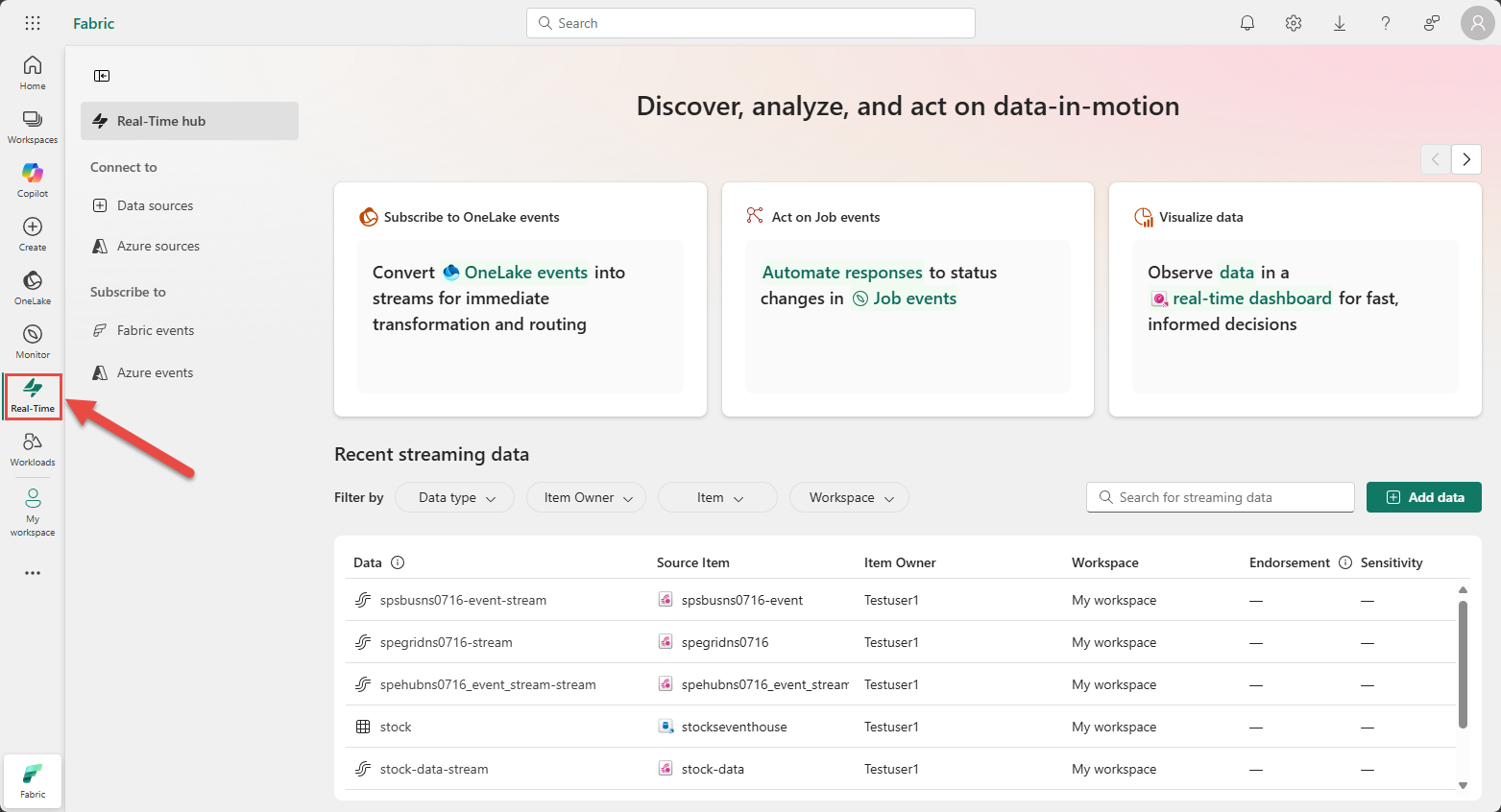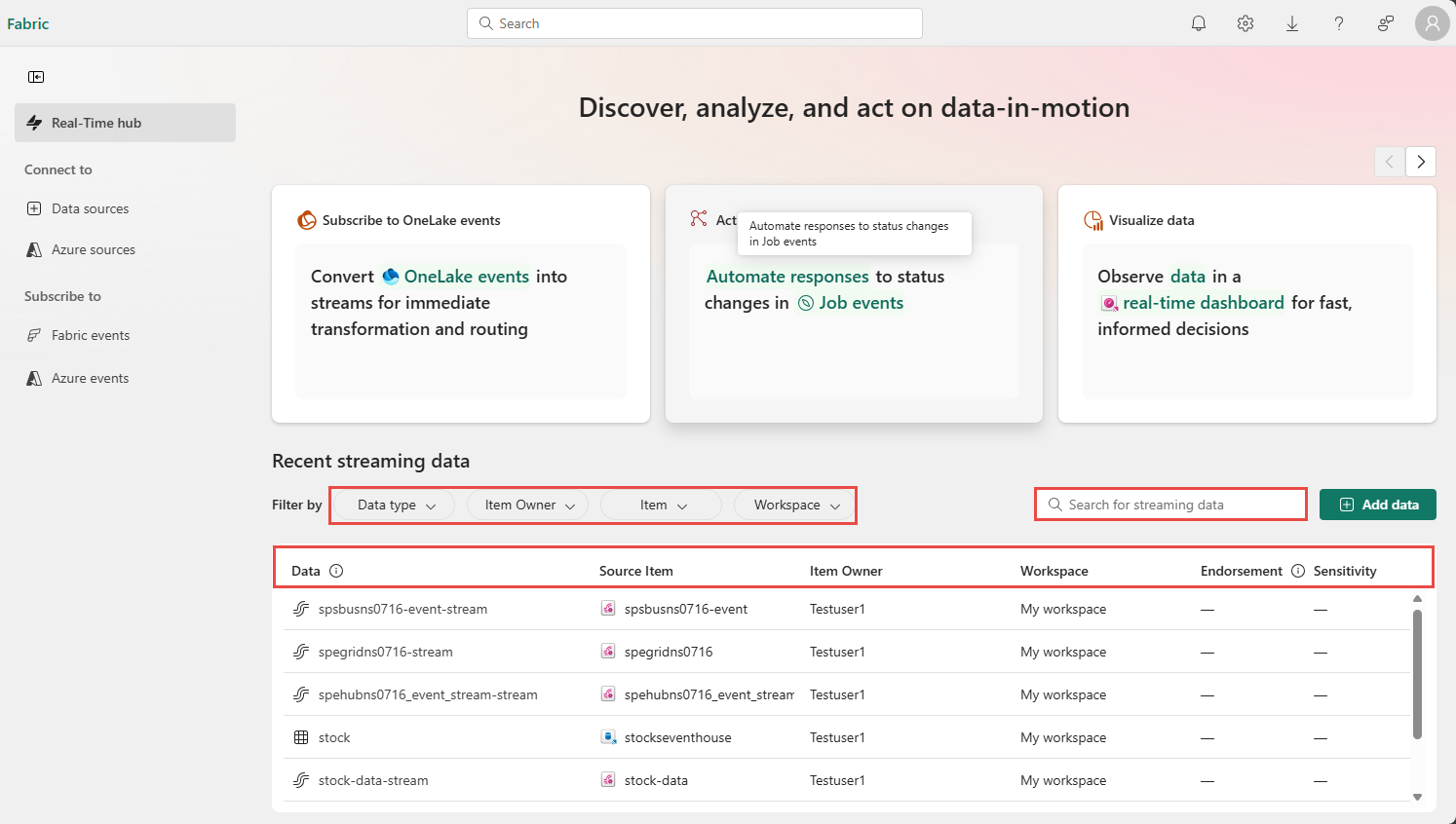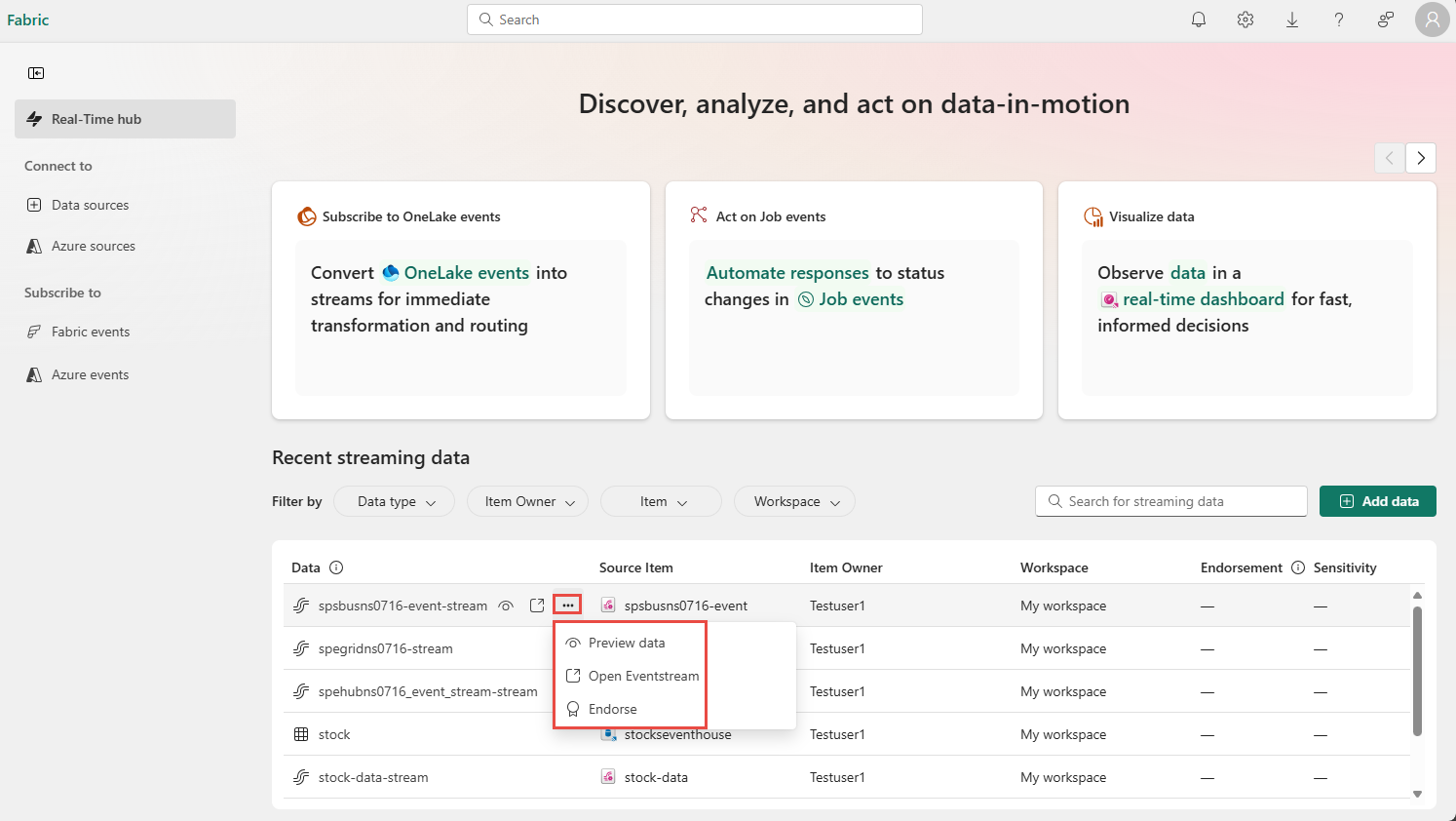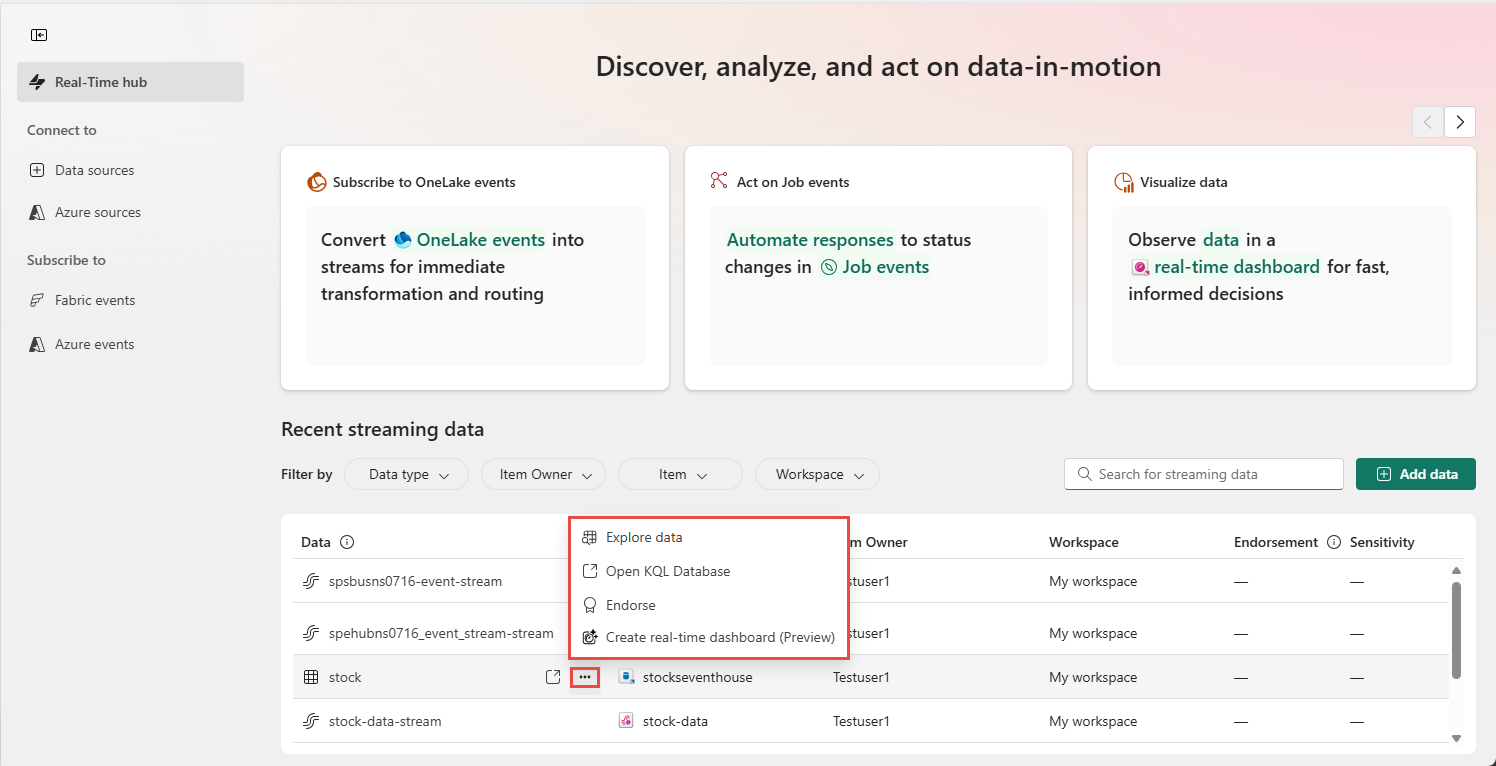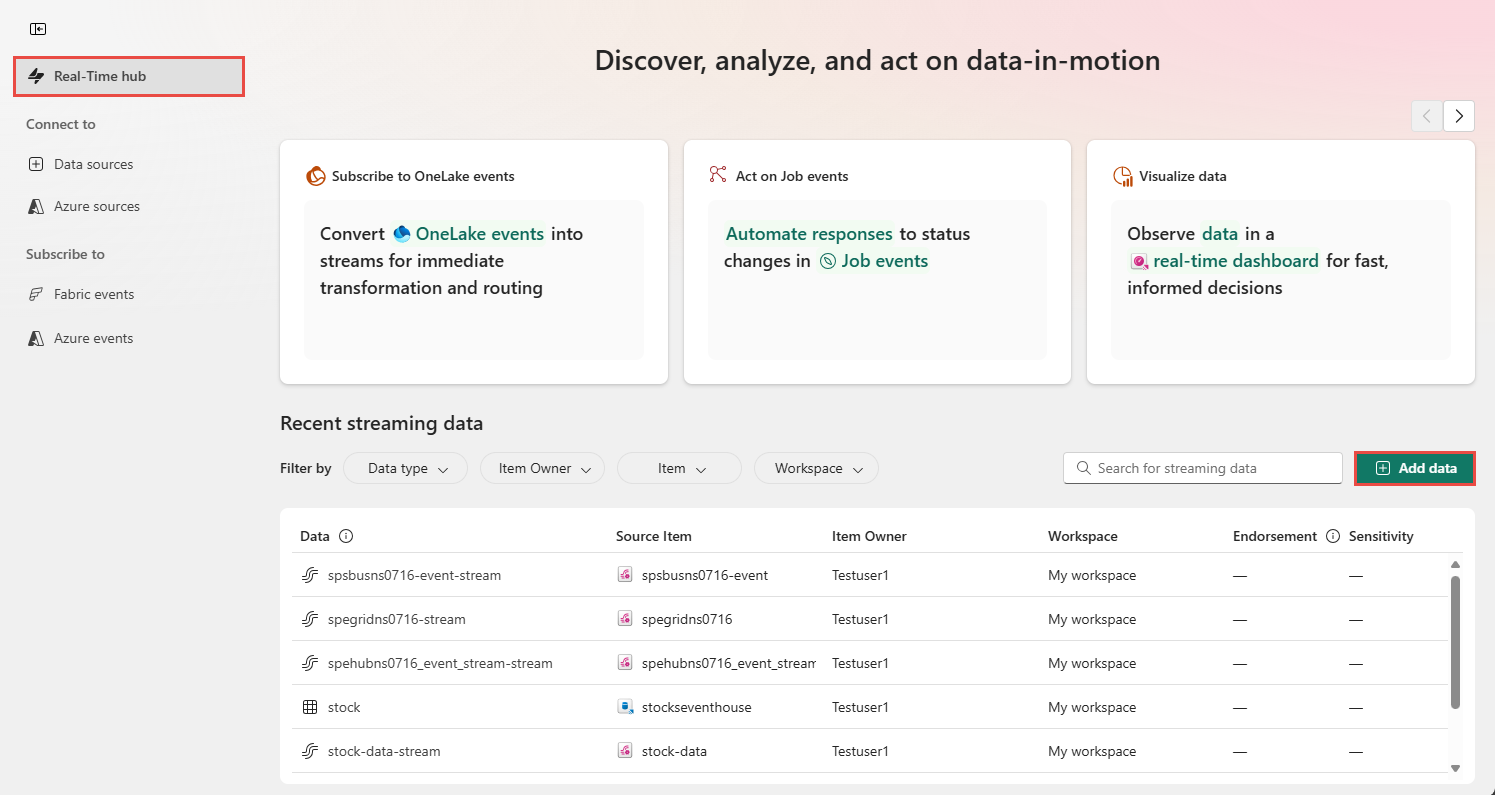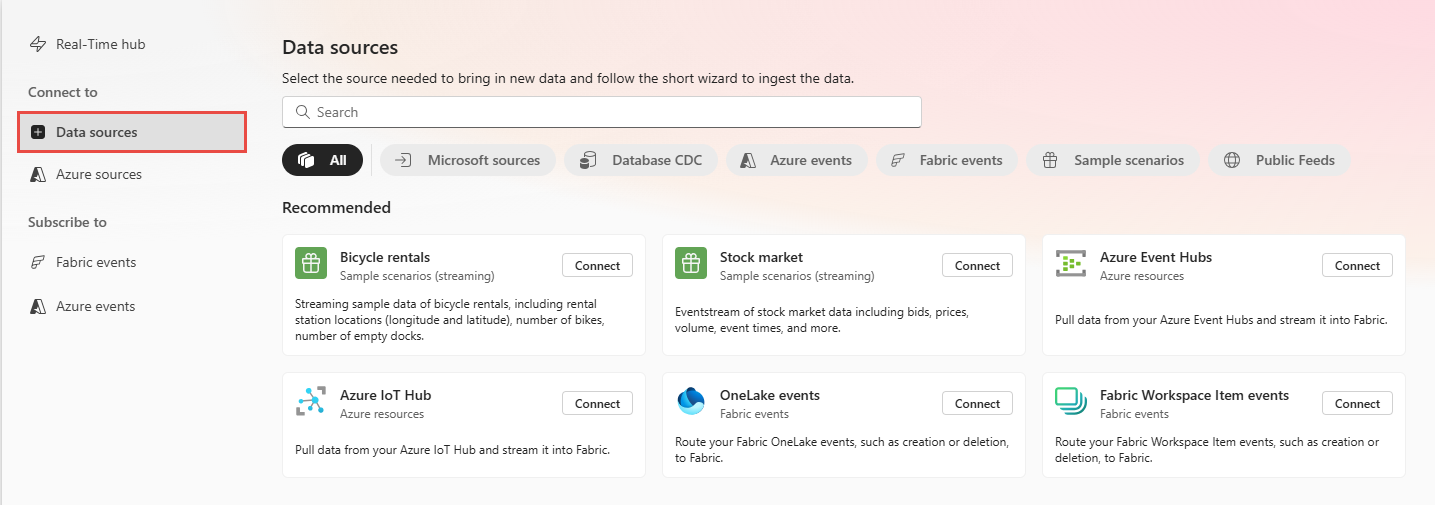Note
Access to this page requires authorization. You can try signing in or changing directories.
Access to this page requires authorization. You can try changing directories.
Real-Time hub is the single estate for all data-in-motion across your entire organization. Every Microsoft Fabric tenant is automatically provisioned with Real-Time hub, with no extra steps needed to set up or manages it. For detailed overview, see Real-Time hub overview.
This article provides guidance on getting started with Fabric Real-Time hub.
Navigate to Real-Time hub
Sign in to Microsoft Fabric.
If you see Power BI at the bottom-left of the page, switch to the Fabric workload by selecting Power BI and then by selecting Fabric.
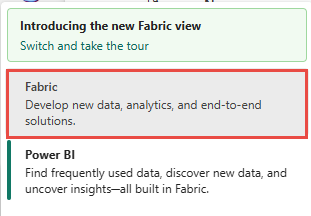
Select Real-Time on the left navigation bar.
Real-Time hub page
On the Real-Time hub page, there are two sections.
In the first section at the top, you see cards or tiles that provide a quick way to performing the tasks:
| Card | Description |
|---|---|
| Subscribe to OneLake events | Provides a shortcut to create streams based on Fabric OneLake events. For details, see Subscribe to OneLake events. |
| Act on Job events | Provides a shortcut to create alerts on Fabric events. For more information, Set alerts for OneLake |
| Visualize data | Provides a shortcut to create a dashboard based on data in a KQL table. |
| Explore data in motion | Provides a shortcut to preview data in a data source. For more information, see Preview data streams. |
| Connect weather data | Provides a shortcut to create a data streams based on real-time weather data. For more information, see Real-Time weather source |
| Learn from a tutorial | Links to the Fabric Real-Time intelligence tutorial that has a module on using the Real-Time hub. |
| Case study | Links to a case study. |
In the All data streams section at the bottom, you see all the streams and tables you can access. Streams are the outputs from Fabric eventstreams and tables are from Kusto Query Language (KQL) databases that you can access.
The All data streams table has the following columns:
| Column | Description |
|---|---|
| Data | Name of the stream or KQL table. |
| Source item | Name of the parent artifact. For a stream, it's the name of the eventstream. For a KQL table, it's the name of the KQL database. |
| Item owner | Name of owner of the parent artifact. |
| Workspace | Name of workspace where the parent artifact is located. |
| Endorsement | Endorsement status of the parent artifact. |
| Sensitivity | Sensitivity status of the parent artifact. |
The following filters are available at the top for you to narrow down easily to the desired stream:
| Filter | Description |
|---|---|
| Data type | You can filter on the data type. Either stream or table. |
| Item owner | You can filter on the name of the owner of the parent artifact. For a stream, it's the owner of the parent eventstream. For a KQL table, it's owner of the parent KQL database. |
| Item | You can filter on the desired parent artifact name. For a stream, it's the name of the eventstream. For a KQL table, it's the name of the KQL database. |
| Workspace | You can filter on the desired workspace name. |
Note
To see streams and tables from only your workspace, select My workspace for the Workspace filter.
Using the search text window, you can search your streams by typing in the name of stream.
Here are the actions available on streams from eventstreams from the All data streams page. Move the mouse over the data stream, select ... (ellipsis) to see the actions.
| Action | Description |
|---|---|
| Preview data | Preview the data in the stream or derived stream. For more information, see Preview data streams. |
| Open eventstream | Open parent eventstream of the stream. After you open the eventstream, you can optionally add transformations to transform the data and add destinations to send the output data to a supported destination. |
| Endorse | Endorse parent eventstream of the stream. For more information, see Endorse data streams. |
Here are the actions available on a KQL table from the All data streams page.
| Action | Description |
|---|---|
| Explore data | Explore data in the KQL table. |
| Create real-time dashboard (Preview) | Create a Real-Time Dashboard with Copilot based on data in the KQL table. |
| Open KQL Database | Open parent KQL Database of the KQL table. |
| Endorse | Endorse parent KQL Database of the KQL table. For more information, see Endorse data streams. |
Data sources page
You can connect to data from both inside and outside of Fabric in a mere few steps within Fabric Real-Time hub. Whether data is coming from new or existing sources, streams, or available events, the Add data experience allows you to connect to a wide range of event sources directly from Real-Time hub.
It allows for easy connectivity to external data streams including Kafka connectors powered by Kafka Connect and Debezium connectors for fetching the Change Data Capture (CDC) streams. Connectivity to notification sources and discrete events is also included, which enables access to notification events from Azure and other clouds solutions including Amazon Web Services and Google Cloud Platform.
There are two ways you can get to the Data sources page:
By selecting + Add data on the Real-Time hub page.
By selecting + Data sources under Connect to category on the left navigation menu.
Then, follow the prompts to complete the flow. Here's a full list of built-in sources.
You can connect to these services and create eventstreams that show up on My data streams and All data streams pages. Select a link for a source in the list to learn how to create an eventstream for that source.
Azure sources page
Azure sources page in the Connect to section shows you all the Azure data sources you can access. They include sources of the following types.
| Source | Description | Learn More |
|---|---|---|
| Azure Event Hubs | A fully managed real-time data ingestion service. | Learn more |
| Azure Service Bus (preview) | A messaging service for reliable communication. | Learn more |
| Azure IoT Hub | A platform for managing IoT devices and data. | Learn more |
| Azure SQL Database CDC | Capture and stream database changes in real time. | Learn more |
| Azure Database for PostgreSQL CDC | Stream changes from PostgreSQL databases. | Learn more |
| Azure Database for MySQL CDC | Stream changes from MySQL databases. | Learn more |
| Azure Cosmos DB CDC | Stream changes from Cosmos DB. | Learn more |
| Azure SQL Managed Instance CDC | Capture changes from SQL Managed Instances. | Learn more |
| SQL Server on VM DB CDC | Stream changes from SQL Server on VMs. | Learn more |
| Azure Data Explorer | Analyze large volumes of data in real time. | Learn more |
You can connect to these resources and create eventstreams that show up on My data streams and All data streams pages. Select a link for a source in the list to learn how to create an eventstream for that source.
Fabric events page
The Fabric events page shows you the list of system events generated in Fabric that you can access. You can create eventstreams for events from your Fabric workspaces. You can also set up an alert to send notifications via email, Teams, etc. when an event occurs. Use links from the list to navigate to articles that show you how to create eventstreams for Fabric workspace item events.
- Fabric Workspace Item
- Explore Fabric events in Real-Time hub.
- Set alerts on Fabric workspace item events
Azure events page
The Azure events page shows you the list of system events generated in Azure that you can access. You can create eventstreams for events from your Azure blob storage. You can also set up an alert to send notifications via email, Teams, etc. when an event occurs. Use links from the list to navigate to articles that show you how to create eventstreams for Azure Blob Storage events.
See following articles to learn how to setup alerts on Fabric events:
